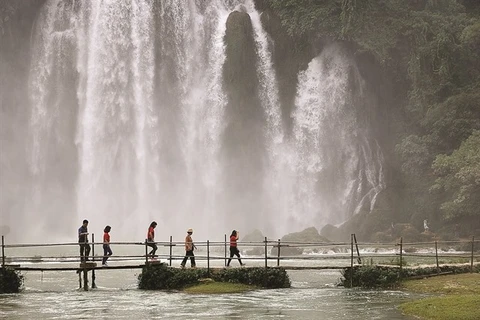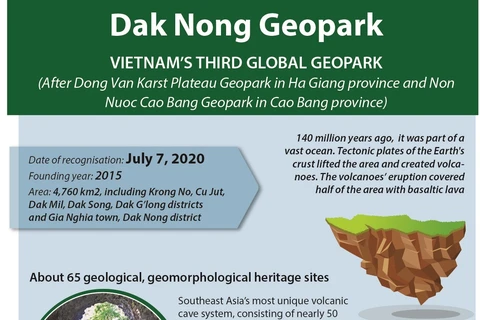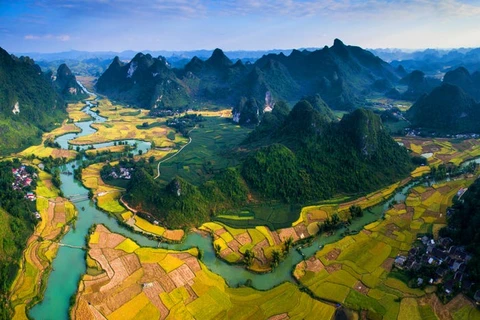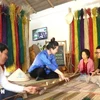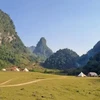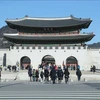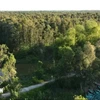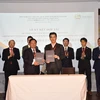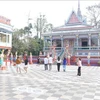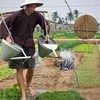Hanoi (VNA) - As a convergence of geological, archeological, cultural and biodiversity values, the Dak Nong Global Geological Park promises to be an attractive destination for international tourists in the future.
The Dak Nong Geopark in Vietnam’s Central Highland province of Dak Nong has recently been recognized as a Global Geopark by the Programme and External Relations Commission of the 209th UNESCO Executive Board.
Located on the M’Nong plateau at average elevation of 600-700m asl, with the highest point being Ta Dung at 1,982m asl, Dak Nong Geopark - the Land of Sounds - (coordinates N12o17’48”; E107o46’58”) covers an area of 4,760km2 of the northern districts of Krong No, Cu Jut, Dak Mil, Dak Song, and Dak G’long districts and Gia Nghia town, according to UNESCO.
The Geopark is home to about 65 geological and geomorphologic heritage sites, including a system of nearly 50 caves with a total length of more than 10,000 metres, craters, and waterfalls.
This park is famous as a rich red land region with tropical forest ecosystem, which holds typical values of biodiversity. It is the land of unique cultural, geological and natural values where traces of prehistoric people were found.
The history of this land goes back 140 million years ago, when it was part of the ocean with traces found such as sedimentary rocks, Ammonite fossil and other fossils. The tectonic movement of the Earth's crust caused this area to be raised and volcanic appearance. Volcanic eruptions covered half of the area with layers of basalt lava.
As a part of the poetic and majestic M'Nong plateau, the Dak Nong Geopark is the convergence of typical geological, archaeological, and cultural and biodiversity values of the region.
The Geopark can be reached by several routes by land and air, including two international border gates with Cambodia. Characterised by sub-equatorial tropical monsoon and plateau climate, the area features an evenly distributed network of rivers, streams, lakes and reservoirs.
A population of 416,000 people of 40 ethnic groups, including 3 autochthonous, live in the area, relying mostly on agro-forestry, trade and services, and small industries.
Many archaeological, historical and cultural relics as well as scenic spots are recognised and conserved. Many festivals and traditions celebrated by ethnic cultures, in particular the UNESCO “Gong Culture Space” intangible heritage (including mankind’s oldest lithophone) also contribute to the values of the Geopark.
Geomorphological and geological values
Dak Nong Geopark is distinctive in terms of geological features and geoheritage value. Being a piece of the Gondwana ancient supercontinent, from about 200-165 Ma ago it was deeply submerged into a passive continent marginal sea, very rich in ammonite and bivalve fossils.
This continental margin later, during 145-66 Ma ago became active due to plate collision, with red-bed sediments, eruptive andesite-dacite-rhyolite and intrusive gabbro-diorite-granodiorite-granite rocks. During the last 16.5 Ma, the territory became active again with wide-spread, multi-phase volcanic activities, forming a basalt cover over more than 50 percent of the Geopark area.
These have been the source of some of the world’s largest and top quality bauxite deposits and a number of other minerals (sapphire, semi-precious stones etc.), and especially the fertile soils that have fed generations of local people with many industrial and fruit tree crops. In particular, young volcanic activities about tens of thousands of years ago (Late Pleistocene-Holocene) have resulted in spectacular craters, majestic waterfalls and Southeast Asia’s most extensive system of hundreds of magnificent volcanic caves, many of which have been used by prehistoric people as shelter since at least 6,000-10,000 years ago.
Preserving and promoting heritage values
Following the UNESCO recognition, relevant agencies, including the Vietnam National Commission for UNESCO, the Ministry of Natural Resources and Environment and provincial authorities, along with domestic and international scientists will jointly implement plans on environmental protection, natural conservation, and rational use of resources in the park.
 Ta Dung lake in Dak Som commune, Dak G'Long district, is dubbed as "Ha Long bay of the Highlands" (Photo: VNA)
Ta Dung lake in Dak Som commune, Dak G'Long district, is dubbed as "Ha Long bay of the Highlands" (Photo: VNA) They aim to preserve and maximise values of geology, biodiversity, culture, history, as well as ethnic traditions of the geopark.
Dak Nong Geopark is a connection model, helping visitors learn about the formation of the earth through geological tours. This model promotes education and raising awareness of visitors of how to live harmoniously with the nature, and the importance to protect values and resources of the nature.
According to Vice Chairman of the provincial People's Committee Ton Thi Ngoc Hanh, the local authorities have planned to enhance the popularization work so that people can understand valuable values of the Geopark, thus preserving and developing them.
Community-based tourism models will be developed in the locality, in which local people will play a key role in preserving the values, she said.
The Dak Nong Geopark is the third UNESCO-recognised Global Geopark in Vietnam after Dong Van Karst Plateau Geopark in Ha Giang province and Non Nuoc Cao Bang Geopark in Cao Bang province, both in northern Vietnam.
According to Director General of the Department of Cultural Diplomacy-UNESCO and Secretary General of the UNESCO Vietnam National Committee Mai Phan Dung, Dak Nong province has made commitments with UNESCO to promote the value of recognition, including building policies, outlining specific economic development strategies, investing in infrastructure development and enhancing popularization work to raise public awareness of protecting and upholding cultural and historical values and traditions of the locality./.




